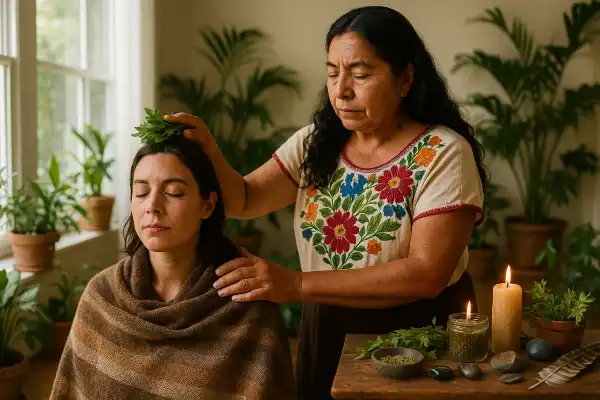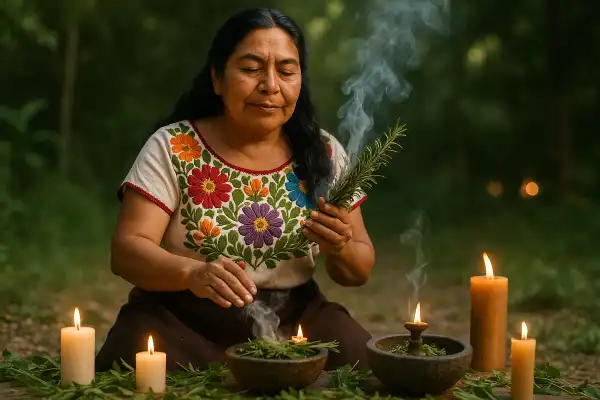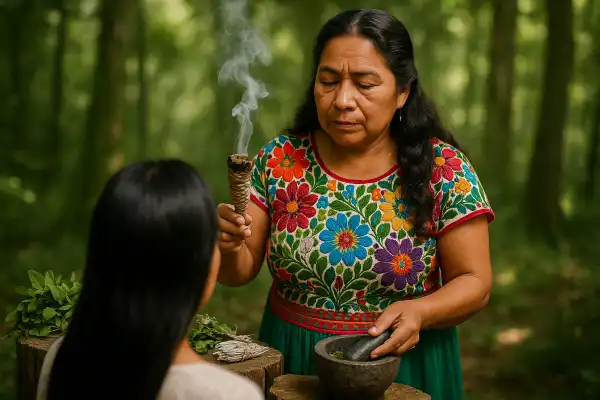The ancient question “What does a curandero do?” comes from deep curiosity about healing traditions that have sustained indigenous communities for countless generations. People seeking this knowledge often feel drawn to understand alternative paths to wellness that honor the interconnection between body, mind, and spirit.
María del Pilar Fernández, drawing from her family lineage of curanderas in Oaxaca and her anthropological studies, believes that answering “What does a curandero do?” requires understanding the profound spiritual calling that guides these traditional healers. She seeks to illuminate this sacred practice through both ancestral wisdom and contemporary insight.
What does a curandero do?
A curandero serves as a traditional healer who practices curanderismo, a holistic approach to wellness that addresses physical, emotional, mental, and spiritual imbalances through indigenous healing methods rooted in Latin American cultures. These healers work through a spiritual calling rather than formal medical training, believing that God or higher powers grant them divine knowledge and healing abilities.
The spiritual foundation of curanderismo
Curanderos use ancient holistic treatments that heal individuals through targeting three hierarchical realms: the religious and/or spiritual realm, the emotional realm, and the process of health and mental illness. Their practice recognizes that true healing extends beyond physical symptoms to encompass the restoration of harmony between an individual and their spiritual essence.
Curanderos often use healthy and appropriate humor during sessions along with prayer, spiritual cleansings, and healing ceremonies to restore balance and harmony to the body, mind, emotions, and spirit of their clients. This approach reflects the understanding that laughter and joy serve as powerful medicine, releasing endorphins that support the body’s natural healing processes.
The diverse specializations within curanderismo
The world of traditional Mexican healing encompasses numerous specialized practitioners, each carrying unique gifts and knowledge:
Yerberos focus primarily on herbal medicine, understanding the medicinal properties of plants native to their regions. These herbalists may include subspecialties such as tabaqueros who work primarily with tobacco, ayahuasqueros who work with ayahuasca, and peyoteros who work with peyote.
Sobadores practice therapeutic massage and bodywork, often performing massage-like therapy to commonly treat “empacho” or constipation and musculoskeletal pain. These healers describe their practice as a deeply intuitive art, where their hands seem to possess an innate understanding of the body’s needs.
Hueseros specialize as bone and muscle therapists, employing a blend of intuition and hands-on experience to diagnose and address injuries. These practitioners emphasize physical ailments, particularly issues related to bones, joints, and musculoskeletal problems.
Parteras serve as traditional midwives, supporting women through pregnancy, childbirth, and postpartum recovery. Many parteras are also skilled sobadoras, hueseras, and yerberas, combining multiple healing modalities to provide comprehensive care.
Oracionistas work primarily through the power of prayer, channeling spiritual energy to support healing. These practitioners use prayer to bring healing powers to medicine, viewing their work as a divine mission rather than a career choice.
Espiritualistas focus on spiritual healing, working with supernatural forces to address emotional and spiritual challenges that manifest as physical symptoms.
Traditional ailments and healing approaches
Curanderos help with illnesses ranging from mundane stomach aches to certain spiritual illnesses such as susto, mal de ojo, and even reversing negative spiritual influences. Traditional communities understand these conditions as forms of spiritual imbalance or loss of vital essence.

Susto, often described as soul loss, occurs when someone experiences shock or trauma that causes part of their spirit to become displaced. Curanderos use specific rituals, prayers, and cleansing ceremonies to call the soul back and restore wholeness.
Mal de ojo represents the harmful effects of intense attention or envy from others. Healing involves spiritual cleansing techniques that remove negative energy and restore protective barriers around the affected person.
Empacho manifests as digestive blockages often treated through combination of herbal remedies, spiritual cleansing, and specialized massage techniques that restore proper energy flow.
The ritual practices of healing
Curanderismo encompasses healing through herbal remedies, therapeutic environments, massage and bodywork, and limpia–a spiritual cleansing that combines natural elements around us. These practices often integrate indigenous traditions with Catholic elements, creating a syncretic healing system that honors multiple spiritual traditions.

Cleansing ceremonies may involve the use of copal incense, sage, or other sacred plants to purify energy fields. Some curanderos guide those dealing with emotional trauma to dig a hole and speak their negative emotions or traumatic experiences into the earth before covering it up as a way to release these burdens from body, mind, and spirit.
The integration with modern healthcare
Contemporary curanderismo is sometimes referred to as complementary medicine, meaning it can work alongside mainstream scientific methods. Rather than an either/or approach, experienced curanderas encourage thoughtful inclusion of traditional indigenous healing practices alongside conventional medical treatments when appropriate.
Traditional healers often serve as the first point of contact for healthcare among Latine individuals in the United States due to accessibility, affordability, and cultural and linguistic compatibility. This reality highlights the important role curanderos play in addressing healthcare access barriers within their communities.
The calling and training of curanderos
Becoming a curandero is more of a calling than a career, and not everyone has the innate gift of becoming a traditional healer. Many curanderos come to their vocation through spiritual calling or family lineage, such as a mother curandero passing knowledge to a daughter.
This sacred knowledge often transmits through generations of family practice, dreams, visions, or profound healing experiences that awaken dormant gifts within individuals. The learning process combines formal apprenticeship with elders, personal spiritual development, and direct experience working with community members seeking healing.
Disclaimer
Please note that Maria is not a physician, psychologist, or nurse. These culture-specific spiritual healing services are not meant to replace medical or psychological diagnosis and treatment. It is recommended that you see a licensed physician or licensed health care professional for any physical or psychological ailment you may have.
Several months ago, María worked with a young woman named Esperanza who had been struggling with persistent anxiety and insomnia following a difficult divorce. Esperanza’s symptoms included heart palpitations, difficulty concentrating, and a persistent feeling that she had lost part of herself in the traumatic separation. After medical examinations ruled out physical causes, Esperanza’s grandmother suggested she visit María.
During their consultation, María recognized the signs of susto—soul loss from traumatic shock. She explained to Esperanza how emotional trauma can fragment our spiritual essence, leaving us feeling disconnected and vulnerable. Together, they performed a traditional calling ceremony at dawn, using copal incense, prayers in Spanish and Zapotec, and gentle energy work to invite Esperanza’s displaced spirit back into wholeness.
María also prepared a custom herbal tea blend with manzanilla, toronjil, and hierba buena to support Esperanza’s nervous system, while teaching her breathing techniques rooted in indigenous practices. Over three sessions spanning two weeks, Esperanza reported significant improvement in her sleep patterns and a growing sense of inner peace and personal strength. María emphasized that this spiritual healing worked alongside Esperanza’s continued therapy sessions, creating a comprehensive approach to her recovery and empowerment.

